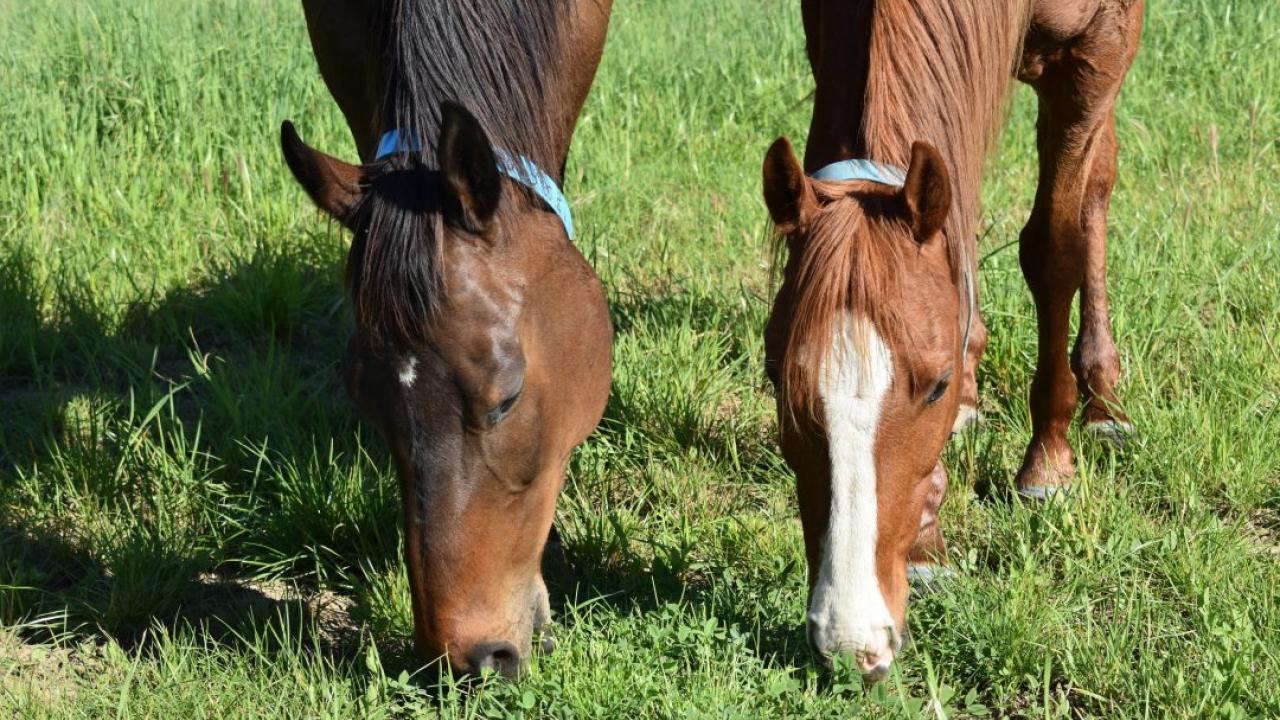For many horses, grazing in a pasture of green grass is a prime source of vitamin E. But when drought and heat dry up those pastures, they take much of the vitamin E with them. The result? An under-the-radar impact of climate change: Horses with vitamin E deficiency.
For horses as well as people, vitamin E is part of a healthy diet and is crucial in preventing neuromuscular disease.
As a report by the UC Davis School of Veterinary Medicine’s Center for Equine Health points out, many horses in arid California do not have access to lush pasture. And hay alone does not fulfill the need for vitamin E once it’s harvested.
But the California drought is technically over. Is vitamin E deficiency still a concern? Amy Young, equine outreach manager with the Center for Equine Health, says yes.
“Many horses in California are not kept in pasture even when the state is not in a drought,” Young said. “Horse owners should evaluate their horses’ diets and talk with their veterinarians if their horses do not have regular access to pasture.”

Grazing horses at UC Davis. (Amy Young, UC Davis)
Hank’s story
The 100-acre Center for Equine Health is a training site for veterinary students, and around 200 horses call the center home. One of the most popular horses at the facility is Hank, a Percheron gelding beloved for his calm, friendly nature.
Hank used to be a carriage horse. But when he stopped being able to back up to the hitch of the carriage, he was out of a job. While standing, he would have tremors and shake violently. He couldn’t even lift his feet for the farrier to work on his hooves. When he was donated to the CEH, veterinarian Tatiana Viau thought that he might have a vitamin E deficiency. After a blood test, her suspicions were confirmed.
Hank was diagnosed with vitamin E deficient myopathy. He started taking vitamin E supplements. Without any other changes to his activities or exercise regimen, Hank regained weight, putting on almost 250 pounds, mostly in muscle. Now happy and healthy, he’s a model patient for veterinary students learning how to perform physical exams. In his off hours, he hangs out in the shade of his pen with a Thoroughbred mare named GI Jane.
Vitamin E deficient myopathy is mostly irreversible, and Hank will be on supplementation for the rest of his life. When CEH informed his previous owners of his diagnosis, they tested their other horses. Blood tests showed they all had low vitamin E levels, despite not showing any signs. The owners now supplement their horses with vitamin E to prevent neuromuscular diseases.

This draft horse arrived at the Center for Equine Health at the UC Davis School of Veterinary Medicine with severe nutrition deficiency. UC Davis veterinarians diagnosed the deficiency and brought him back to health. He is now thriving and a permanent resident of the CEH and used for teaching veterinary students. (Don Preisler/UCDavis)
An ounce of prevention
Not all horses with vitamin E deficiency show clinical signs, but it is important to identify any deficiencies and ensure a balanced, complete diet before signs arise.
Dr. Carrie Finno, director of the Center for Equine Health, reminds horse owners to always consult with a veterinarian regarding their horses’ health. Finno also stresses the importance of obtaining a baseline vitamin E blood concentration before beginning to supplement.
“If we don’t know where the horse started, it is often hard for us to determine the type and amount of supplementation required and the horse’s response to various protocols,” said Finno, who studies equine neuromuscular diseases.
So what should horse owners do?
Finno suggests:
- Work with your veterinarian to establish a balanced, complete diet for your horse before vitamin E deficiency signs arise. Foals and pregnant mares can receive supplementation as a first line of prevention.
- Perform a blood test and record baseline vitamin E level before you initiate any supplementation. Ideal levels of vitamin E in the blood are between 3-5 µg/ml. The California Animal Health & Food Safety Laboratory conducts blood testing across the state. The proper dose of vitamin E will depend on your horse’s baseline concentration and the supplement itself.
- Make sure the supplement you choose is in the natural (“-d), not synthetic (“-dl”), form. The natural form is easier for the horse’s body to process and absorb.
- Monitor vitamin E levels to track the efficacy of the supplements and prevent excess supplementation, which can result in bleeding disorders and other health issues.
News and updates from the Center for Equine Health are available at https://ceh.vetmed.ucdavis.edu/news
Media Resources
Leigh Houck is a science communication intern with UC Davis Strategic Communications's News and Media Relations team.
